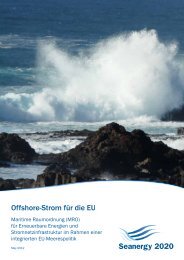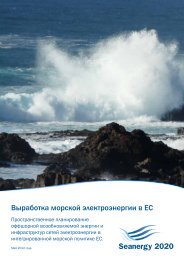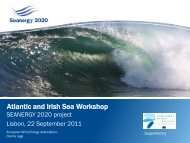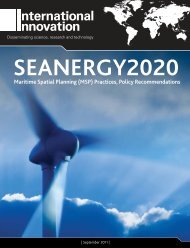Comparative analysis of Maritime Spatial Planning ... - Seanergy 2020
Comparative analysis of Maritime Spatial Planning ... - Seanergy 2020
Comparative analysis of Maritime Spatial Planning ... - Seanergy 2020
You also want an ePaper? Increase the reach of your titles
YUMPU automatically turns print PDFs into web optimized ePapers that Google loves.
Spain according to the national reports. There may also be the need for regional co-ordination particularlyin Germany, whilst in Sweden co-ordination is largely regional through four regional authorities. Clearly,however, a wider commitment to co-ordination across the Community is to be encouraged.Conclusions on best practiceThere is therefore no single best practice in dealing with licensing and the steps it takes. The principleobjectives are to streamline the system to provide a license process that gives assurances thatinteractions between the wind power sector and other users <strong>of</strong> the sea have been duly taken into account,in accordance with the principles <strong>of</strong> MSP, whilst keeping down the administrative costs.In terms <strong>of</strong> this streamlining it is probably significant that by and large those countries with the greaterreported installed capacity or with the highest targets for planned installations tended to have the moststreamlined process. The UK has the highest reported installed capacity at 1,341MW with targets for afurther 12,900MW by <strong>2020</strong> whilst, followed by Denmark with 853MW installed capacity. Germany and theNetherlands have the second highest targets <strong>of</strong> 10,000MW and 6,000MW respectively with significantexisting installed capacity. The WINDBARRIERS project showed that in terms <strong>of</strong> the number <strong>of</strong> direct andindirect contacts necessary to gain full approval Denmark required 5.15, Netherlands 6.27 and UK 15.2,all <strong>of</strong> which are well below the overall average for all Member States for Offshore wind projects <strong>of</strong> 22.8.Thus, whilst there may be no single set <strong>of</strong> best practices to achieve the streamlined co-ordination processwhat this does show is the importance <strong>of</strong> a committed policy to the sector and to maritime planning inachieving the objective <strong>of</strong> an efficient process. Consequently the spring board <strong>of</strong> best practice is a soundand proactive policy towards Offshore Renewables.It seems that one <strong>of</strong> the key driving factors for the introduction <strong>of</strong> more integrated, comprehensivemaritime spatial systems is the extent <strong>of</strong> competing economic demands from different sectors on thespace and an interest to develop economic activities in marine areas. Without making invidiouscomparisons since each state has its own priorities, in Germany there has been a particular policycommitment to increasing exploitation <strong>of</strong> <strong>of</strong>fshore wind energy, which exposed a range <strong>of</strong> potential spatialconflicts that needed addressing; whilst in France up until recently, despite having jurisdiction on one <strong>of</strong>the largest maritime zones in the world, development <strong>of</strong> economic maritime activities has not been apriority <strong>of</strong> the French Government, which has focused primarily on rural areas (agriculture, industry).Similarly for Poland, there are few activities in the Baltic Sea (limited to fishing, shipping as well as some oiland gas extraction), and therefore there has been less <strong>of</strong> a need for MSP. In France, the situation hasrecently changed somewhat, in as much as tenders have now been launched and maritime areas openedfor <strong>of</strong>fshore wind parks.A further overall indicator <strong>of</strong> the efficiency and effectiveness is the total duration <strong>of</strong> the permitting processsince co-ordination must be a factor here. The duration <strong>of</strong> the permit process can be as little as 10 weeksin Sweden or 6 months to a year in Belgium and just over a year in the Netherlands although it can be upto four years in some <strong>of</strong> the UK administrations. Related to this is the period <strong>of</strong> validity once permits haveDeliverable 2.323 | P a g e






